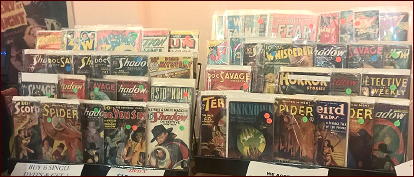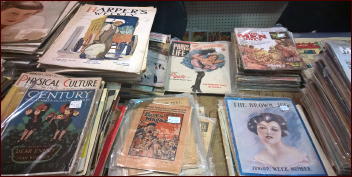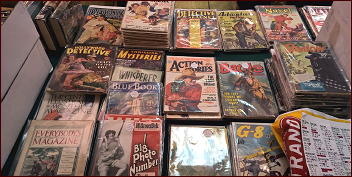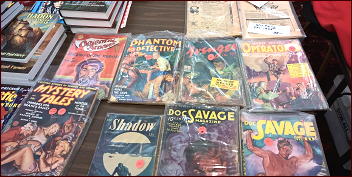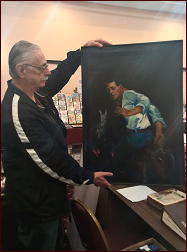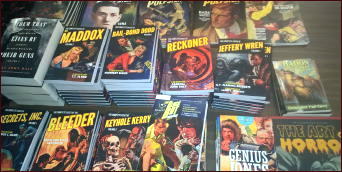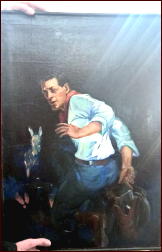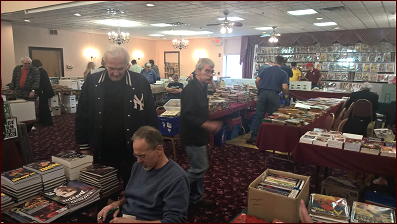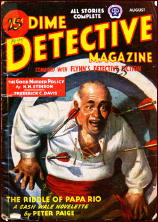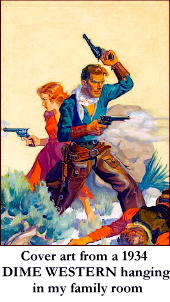Tue 26 Jul 2016
CON REPORT: PulpFest 2016, by Walker Martin.
Posted by Steve under Collecting , Conventions , Pulp Fiction[31] Comments
by Walker Martin
This convention is getting better and better, and frankly if you read or collect the old fiction magazines, then you must attend it.
This year it was held between July 21 through July 24, 2016, but this time it ran into a major conflict. I’m talking about the gigantic media event called the San Diego Comicon. Thousands of people attend the Comicon but for me and 425 other book and pulp collectors, we would rather travel to Columbus, Ohio for Pulpfest. After all, my interest in comics ended at age 10, and I would rather watch an old film noir movie rather than the Hollywood comic character movies that are being cranked out. I mean we are book collectors, which is a lot more fun, and we love reading old pulps, books, digest fiction magazines, and vintage paperbacks.
So, having made our decision to skip Comicon, four of us rented our usual van and traveled out on a 10 hour drive. We found plenty to talk about because all four of us are interested in different aspects of the addiction known as bibliomania. But to protect the reputations of my long time friends I will refer to them only as The Reading Machine, The Publisher, The Dealer, and The Collector.
Among the 425 attendees at the convention, are some pretty hard boiled characters that do not let anything stand in the way of their desire to collect books and pulps. For instance Ed Hulse, of BLOOD n THUNDER, felt ill on Thursday, went to the emergency room of a nearby hospital, was admitted, and assigned a bed while tests were being conducted.
However, the next day, he said to hell with this and returned to the dealer’s room Friday afternoon. Normal behavior for a book collector. I mean who wants to miss the chance of obtaining their wants? They call us bibliophiles for a reason…
Each convention something new and exciting happens. This year two of my favorite collector friends received major pulp awards. Laurie Powers received the Munsey Award for her pulp research into the lives of Paul Powers and Daisy Bacon, the editor of LOVE STORY. She also has a blog titled Laurie’s Wild West. David Saunders won the Lamont Award for his research into the lives and careers of many pulp and slick artists. He has an excellent website which deals with pulp artists. They couldn’t give him a Munsey Award because he created it, so they came up with the great idea of awarding The Lamont, which was the major award given by the earlier Pulpcon conventions.
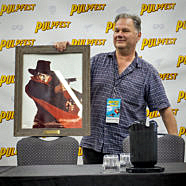
I always score big at these conventions. Sometimes I find some great pulp cover art and often I buy some rare books or pulps. This year I took delivery of the best years of ADVENTURE magazine, 1921-1928. I already have them but I love to compare issues and drive myself crazy trying to figure out which is the better copy. About two or three years ago I saw a brief sentence in one of Mike Chomko’s book catalogs about selling his ADVENTURE set, over 200 issues. This caused me to nag and harass Mike for a long time about selling them to me. I want to extend my apologies to Mike now that I have the magazines safely in my possession. He admitted that he almost changed his mind and kept the set because there is so much good fiction in them. But being the insane collector I am, I had to have them to satisfy my pulp addiction. To hell with women, drugs, booze, or gambling. I’ll take books and pulps every time!
Needless to say, my fellow voyagers were less than pleased to see me dragging five long comic boxes of pulps to the van. Especially since The Reading Machine and The Dealer also had many, many boxes. But somehow we managed to shoehorn them in. The Publisher keeps muttering that The Reading Machine and The Collector think the vans are made out of rubber which is expandable. But one day we will arrive and find out that the boxes don’t fit. Then the chips will fly! Pulp chips that is.
What else did I get? How about a great letter from Mary Gnaedinger, the editor of FAMOUS FANTASTIC MYSTERIES, on Popular Publications letterhead, addressed to Calvin Beck, the future editor of CASTLE OF FRANKENSTEIN.
Also I was weeping bitter tears because I did not win the door prize of Mike Ashley’s SCIENCE FICTION REBELS, the fourth volume of his superb history of the science fiction magazines. If there was any justice in the world he should win a major award for this series. The book costs over $100 but I offered the door prize winner a lower price for the book and he accepted. I have no shame. To get my wants, I’ll whine, beg, borrow and harass collectors until they give in.
But my biggest find was the November 10, 1923 WESTERN STORY for only $20. Now you may ask why on earth am I so happy about this? After all, it’s only one pulp. But I have almost 1300 issues of WESTERN STORY, 1919-1949 and only needed eleven issues. Now I only need ten! Did I say anything about bibliomania and bibliophiles? I guess you have to be an addicted collector to understand my joy.
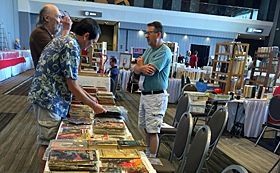
One of the big things about Pulpfest, is the great programming. There are plenty of gamers, new pulp writers, Philip Jose Farmer fans, all busy with readings, panels, etc. But my favorites occurred during the evening after the closing of the dealer’s room (I could never leave the dealer’s room, god forbid!). I won’t go into them all but I really enjoyed David Saunders on “The Artists of The Argosy” and Doug Ellis on “120 Years of The Argosy.” Another of my favorites was Laurie Powers talking about LOVE STORY and Daisy Bacon.
Despite being ill a few hours earlier, Ed Hulse joined me in discussing WESTERN STORY MAGAZINE and the Evolution of the Pulp Western. We covered the best western titles such as WESTERN STORY, WEST during the Doubleday years, and the two big titles from Popular Publications: DIME WESTERN and STAR WESTERN. We even mentioned the terrible western titles.
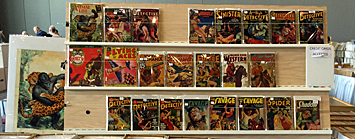
But the best part of the programming was the Guest of Honor speech by Ted White, former editor of AMAZING and FANTASTIC. He was editor during 1968-1978 and somehow, despite a small budget, managed to publish two quality SF magazines. A great achievement. I have complete runs of these digests, over 100 issues and they are full of enjoyable fiction. Ted White’s editorials are also very enjoyable.
The auction was over 100 lots and very varied. Pulps, books, artwork, premiums, slicks, and fanzines. The biggest price paid was $650 for a copy of BEYOND THE WALL OF SLEEP, by H. P. Lovecraft, but some lots reached $250 like the Doc Savage subscription premium and 5 issues of LARIAT.
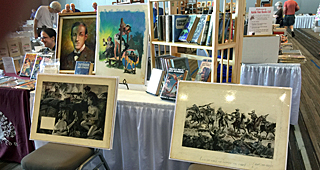
THE PULPSTER was issue number 25, and this magazine appears to be getting better and better with each annual issue. William Lampkin is the editor, and he had articles on 90 Years of Amazing Stories by former editors and Second String Heroes. Also David W. Smith talked about “What Becomes of Your Pulps After You’re Gone” (I’m taking mine with me); Art Sippo on Philip Jose Farmer; J. Randolph Cox on Street & Smith’s DETECTIVE STORY; David M. Earle on HARLEM STORIES; and I related my adventures collecting WESTERN STORY MAGAZINE. A task that could have ruined my work career and maybe got me fired.
I noticed more pulp t-shirts than usual. I’m always wearing them and this year I had DIME MYSTERY, ADVENTURE, FAMOUS FANTASTIC MYSTERIES, and Fred Davis. But I also saw other collectors wearing ADVENTURE, ARGOSY, SHORT STORIES, and BLACK MASK.
Speaking of BLACK MASK, everyone was buzzing about the recent acquisition by Matt Moring of the BLACK MASK title. Soon we will see collections reprinting some of the great fiction series! Matt says there is no truth in the rumor that he is trying to get the rights of also owning the actual back issues of all the pulps. I’m worried that sheriff deputies might confiscate my collection and turn it over to Matt.
This year dealers received a gift when they registered. We were given a baseball cap that had “Pulpfest” on it. I’m hoping to get another t-shirt next year. And finally I’d like to thank the Pulpfest committee for all their hard work: Jack and Sally Cullers and their family and friends, Mike Chomko (thanks also for the ADVENTURES, Mike!), Barry Traylor, Chuck Welch, and Bill Lampkin. Believe me, we pulp collectors appreciate your efforts.
OK, the next pulp show on my schedule is Pulp Adventurecon which is always held in Bordentown, NJ in early November. See you there!
THANKS to Sai Shankar and William Lampkin for the use of the photos they took during during the course of the convention. That’s me talking to David Saunders in one just above. I’m the one on the right.
